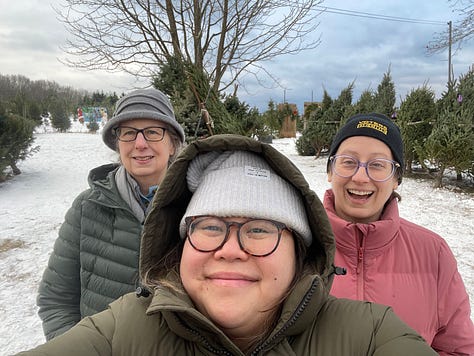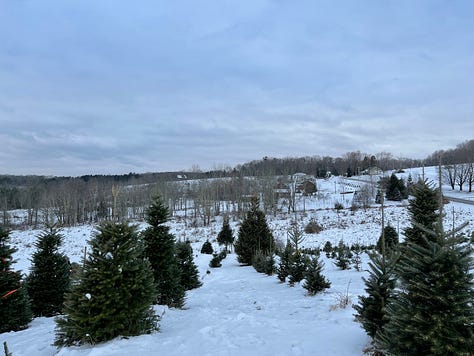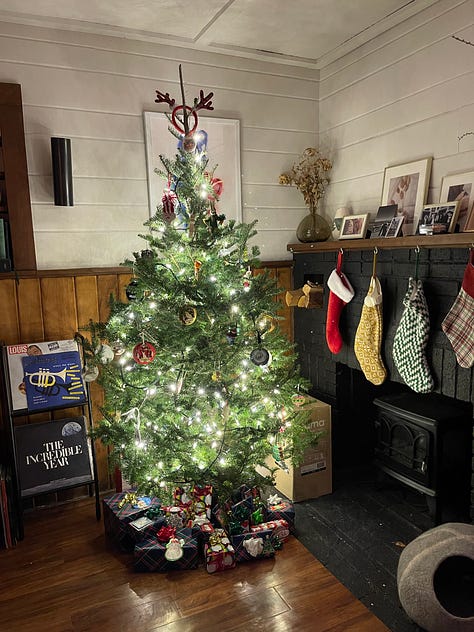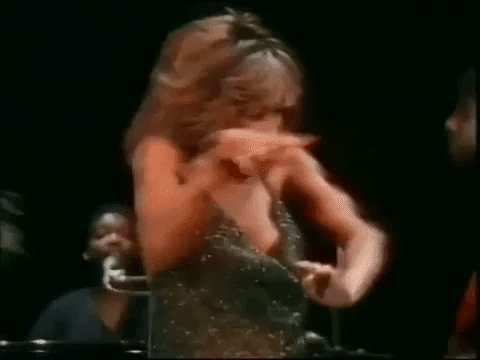On being radically present with our bodies
And letting go of the narratives we hold about our physical form this holiday season



Yesterday, my wife and mother-in-law and I went to a Christmas Tree farm. None of us identify as Christian so Christmas has become more of an opportunity for us to gather and engage in togetherness.
Decorating the tree with Jess has become one of my favorite holiday pastimes, as each year we look through the many rows of trees, grab a cup of hot cocoa, and see what tree speaks to us. Upon arrival, Jess’ mom asked us what kind of tree we prefer to which we both emoji shrugged and answered that we just kind of feel it out.
As we were searching for the right tree, I realized in that moment, we literally meant feeling it out. We would eye the tree up and down but ultimately would choose a tree based on how its pines felt on the tip of our fingers, how it smelled when leaned into the branches.
We chose our tree — about 6’ tall, with soft needles, and a sweet earthy subtle smell. As the family employees wrapped up our tree, I walked to the top of the snow-covered hill and looked out over the vista at the trees still planted in the ground. It was about 17 degrees outside and the ice-like wind brushed up against my cheek as I inhaled the sharp winter air, which helped me take in the full landscape below. The brutal cold woke me up, that made me feel alive, so that I just didn’t place me in the present moment but allowed me to be in the present moment, in my body.
***
I have always had a complicated relationship with my body.
Growing up, like so many young women, I saw my body as a reflection of my value, my worth — which I learned years later from Sabrina Strings was a social standard set by some affluent European dudes who prioritized symmetry, perfection when it came to what they thought was the perfect form.
As someone who has struggled with her weight all her life, it is miraculous that I didn’t develop an eating disorder growing up. I was constantly compared to my female cousins, who embodied much more of what was considered the beauty standard for Asian women: petite, fair skinned and demure in expression.
For most of my life, I was none of those things. Sure I was 5’1, but I was always a little overweight, and today I am considered obese according to the BMI system. And it has been a lifelong struggle to fit myself into a standard that both physically and spiritually forced me to be smaller than I naturally was. I have ping-ponged with my weight my entire life, trying any and every diet that was available to me — Atkins, Weight Watchers, South Beach, Keto. You name it and I’ve probably tried it.
And even as I write this, I feel a small ache in my chest, left of my heart, where 14-year-old Kim is wondering, you’re still dealing with this shit?
I share all of this because I have spent most my life avoiding my body. I never wanted to be in touch with the physical form of myself because it reminded me of all the ways I was not enough. Along the way, I did a Tough Mudder, training twice a day which honestly just furthered me more into the downward spiral of self-hatred. I discovered and fell in love with yoga but was scarred after finding out that most of my teachers were either racist or emotionally manipulative.
So as I have dived more deeply into my mindfulness practice over the last decade, I tried to distance and separate my body from my practice to avoid feeling the many forms of trauma and baggage I associate with my body.
But of course that didn’t work. The sheer act of my sitting practice and connecting with my breath was, I realize now, an act of connecting with my body. I have learned that I can not outrun my body with my mind because my mind is my body; my body, my mind.
I know there is much to undo — thinking and conditioning; pain and judgment that started centuries before me. The question was: was I to become part of the tragic pattern or could a pave a new path for myself?
The First Foundation of Mindfulness
Contemplation of the body is the first of the Four Foundations of Mindfulness; it is made of 16 exercises which I won’t detail all here, but will share those which have been most effective for me.
The Four Foundations of Mindfulness are:
Mindfulness of body (kāyā)
Mindfulness of feelings (vedanā)
Mindfulness of mind/heart (citta)
Mindfulness of qualities (dhamma)
In the past, I have tried my best to focus on the other pillars — feelings, mind/heart, qualities — and though made much progress, I knew deep down how much wisdom lives in the body, I knew that if I wanted to truly heal that I had no choice but to deeply into my blood, bone, heart.
I started learning about how trauma lives in our body, how practicing somatic awareness could start a new way of thinking not just for me, but for all of us.
And I started to realize that even if I wasn’t lifting 80 lbs, doing sun salutations, or running marathons, that every time I brought awareness to my breath, I was actually getting in touch with my body. Over and over again.
It wasn’t until the last two years that I have slowly found ways to get back in touch with my body, letting myself feel my skin, my belly, the weight of me.
I have let myself feel, not judge.
This is the practice: To let go of that voice of self-hatred, of disgust, and come back to a place of neutrality — to not focus on criticism but instead observe how and what my body is experiencing in any given moment. To give myself the spaciousness to see what the full picture of me feels like, so that I can allow awe, love, and gratitude to seep in.
It has been a long journey but one in which has liberated me, my body, which in turn has freed my mind from the minefield of self-image that used to plague me. It is, of course, still a work-in-progress but there is forward motion, movement — mindful movement — towards a place where I can allow myself to just be in my body.
***
I decided last month that I’d love to feel lighter and stronger in my body.
It’s something I’ve wanted to work on for the past several years but have been afraid to, but after practicing some mindful movement at a retreat, I knew it could be different this time. It didn’t have to be about the weight loss, it could be about my experience, it could be my joy in the journey, it could be something more, it could come from a place of love and acceptance.
When I worked out twice last week, I celebrated the fact that I moved my body, that I did the thing, that I felt good and energized after. I found myself sharing with my BFFs that I worked out and we all lovingly celebrated each other’s commitment to be active — however small. (Shoutout to them and their own growth and supporting me along the way all these years!)
This was the shift. This was the win. Just being in my body and not hating myself was the biggest gift I could have ever asked for. I guess Christmas came early this year for me.
And even though I am the heaviest I have ever been in my life, I have not been spending hours shaming myself or obsessing over the numbers on the scale but instead just seeing it for what it is — data to help guide me in the direction I want to be. Instead, I am prioritizing the most important data: my experience in my body and asking myself: Am I feeling nourished? Strong? How are my energy levels? Am I feeling like a motherfucking badass?
I’m happy to share that I have been. And that to me is better than any beach body I could have. Finding a sustainable path forward not just for my body, but for my mind and my spirit — for all of me.
Here are more resources however for you to discover for your own journey:
The Buddha’s Four Foundations of Mindfulness by Bhikkhu Bodhi
Spirit Rock: The Four Foundations of Mindfulness by Sean Oakes
Body Contemplation: A Study Guide by Thanissaro Bhikkhu
What Is Your Body? by Norman Fischer
Awakening in the Body by Phillip Moffitt
For me, this simple cue that Zen Master Thích Nhất Hạnh shares has been simple, effective and had a lasting impact on enabling me to connect with my body through my practice:
The Pali expression, “kaye kaya anupassana”, the body in the body, contemplation of the body in the body. And you do that right in the beginning. When you begin to practise mindful breathing, don’t consider your in-breath as something outside of your mind. Experiencing my in-breath, I breathe in; experiencing my out-breath, I breathe out. You become one with your in-breath. You become one with your out-breath. You don’t stand outside. So during the time of breathing in, you don’t stay as an outside observer to observe your in-breath, no. You don’t recognise, “This is my in-breath, and this is me observing my in-breath”. That’s not correct. You have to be one: experiencing my in-breath, I breathe in; experiencing my out-breath, I breathe out. And when you come to the body, you do the same: experiencing my body, I breathe in. So, you become your body. And because your in-breath and out-breath have become calm, more peaceful, your body will become naturally calm, more calm, and peaceful. And you don’t have to do anything. You don’t have to force your breath. You don’t have to force your body. So, the expression “working on our breath” is not correct. It’s not working on our breath – just being with our breath. And mindfulness will do the thing that you wanted to do.
I’d love to know your journey with your body:
What have you struggled with? What challenges are you trying to overcome? What kind of experience do you want to have when being present with your body?
A gift for you
One of the ways I love to be radically present in my body is to dance. I started making a playlist that helps me tap into that deep feeling of liberating the body. You can access it here. I’ve made it collaborative so we can all add to it.
Let’s dance and be free together.





Thank you for this! It spoke to me on my journey of illness and learning how to listen to my body. It is fascinating how, when you're reduced to the bare essentials, you see clearly. Loved the links to the articles.
Love you!! This is beautiful, relatable, and what many of us need to read xoxo